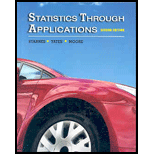
Concept explainers
(a)
To Explain: a goodness of fit test to see if there is sufficient evidence to conclude that spinning the coin does not produce an equal proportion of heads and tails.
(a)
Answer to Problem 10.31E
There is enough evidence to help the claim that spinning the coin does not produce an equal proportion of heads and tails.
Explanation of Solution
Given:
Formula used:
Calculation:
Given:
Assume
The null hypothesis statement is that the population proportions are equal to the given proportions
The alternative hypothesis statement is the opposite of the null hypothesis:
The expected frequencies
The value of the test- statistic is then
The degree of freedom is
The P-Value is the probability of getting the value of the test statistic, or a value more extreme and
If the P-value is equal or less than to the significance level, then the alternative hypothesis is accepted and null hypothesis is rejected:
There is enough evidence to help the claim that spinning the coin does not produce an equal proportion of heads and tails.
(b)
To Explain: whether spinning the coin is equally likely to result in heads or tails.
(b)
Answer to Problem 10.31E
There is enough evidence to help the claim that spinning the coin does not produce an equal proportion of heads and tails.
Explanation of Solution
Given:
Formula used:
Calculation:
The claim is either the null hypothesis or the alternative hypothesis
The sample proportion is the number of outcomes divided by the
Test-statistic is
The P-Value is the probability of getting the value of the test statistic, or a value more extreme
If the P-value is smaller than the significance level
There is enough evidence to help the claim that spinning the coin does not produce an equal proportion of heads and tails.
(c)
To Explain: the results of part (a) and (b) comparatively.
(c)
Answer to Problem 10.31E
Same conclusion
Explanation of Solution
It observed that the part (a) and part (b) saying the same conclusion, there is no difference in the in part (a) and part (b).
Chapter 10 Solutions
Statistics Through Applications
Additional Math Textbook Solutions
Pre-Algebra Student Edition
Elementary Statistics: Picturing the World (7th Edition)
Elementary Statistics (13th Edition)
Calculus: Early Transcendentals (2nd Edition)
Basic Business Statistics, Student Value Edition
- Find the critical value for a left-tailed test using the F distribution with a 0.025, degrees of freedom in the numerator=12, and degrees of freedom in the denominator = 50. A portion of the table of critical values of the F-distribution is provided. Click the icon to view the partial table of critical values of the F-distribution. What is the critical value? (Round to two decimal places as needed.)arrow_forwardA retail store manager claims that the average daily sales of the store are $1,500. You aim to test whether the actual average daily sales differ significantly from this claimed value. You can provide your answer by inserting a text box and the answer must include: Null hypothesis, Alternative hypothesis, Show answer (output table/summary table), and Conclusion based on the P value. Showing the calculation is a must. If calculation is missing,so please provide a step by step on the answers Numerical answers in the yellow cellsarrow_forwardShow all workarrow_forward
- Show all workarrow_forwardplease find the answers for the yellows boxes using the information and the picture belowarrow_forwardA marketing agency wants to determine whether different advertising platforms generate significantly different levels of customer engagement. The agency measures the average number of daily clicks on ads for three platforms: Social Media, Search Engines, and Email Campaigns. The agency collects data on daily clicks for each platform over a 10-day period and wants to test whether there is a statistically significant difference in the mean number of daily clicks among these platforms. Conduct ANOVA test. You can provide your answer by inserting a text box and the answer must include: also please provide a step by on getting the answers in excel Null hypothesis, Alternative hypothesis, Show answer (output table/summary table), and Conclusion based on the P value.arrow_forward
 MATLAB: An Introduction with ApplicationsStatisticsISBN:9781119256830Author:Amos GilatPublisher:John Wiley & Sons Inc
MATLAB: An Introduction with ApplicationsStatisticsISBN:9781119256830Author:Amos GilatPublisher:John Wiley & Sons Inc Probability and Statistics for Engineering and th...StatisticsISBN:9781305251809Author:Jay L. DevorePublisher:Cengage Learning
Probability and Statistics for Engineering and th...StatisticsISBN:9781305251809Author:Jay L. DevorePublisher:Cengage Learning Statistics for The Behavioral Sciences (MindTap C...StatisticsISBN:9781305504912Author:Frederick J Gravetter, Larry B. WallnauPublisher:Cengage Learning
Statistics for The Behavioral Sciences (MindTap C...StatisticsISBN:9781305504912Author:Frederick J Gravetter, Larry B. WallnauPublisher:Cengage Learning Elementary Statistics: Picturing the World (7th E...StatisticsISBN:9780134683416Author:Ron Larson, Betsy FarberPublisher:PEARSON
Elementary Statistics: Picturing the World (7th E...StatisticsISBN:9780134683416Author:Ron Larson, Betsy FarberPublisher:PEARSON The Basic Practice of StatisticsStatisticsISBN:9781319042578Author:David S. Moore, William I. Notz, Michael A. FlignerPublisher:W. H. Freeman
The Basic Practice of StatisticsStatisticsISBN:9781319042578Author:David S. Moore, William I. Notz, Michael A. FlignerPublisher:W. H. Freeman Introduction to the Practice of StatisticsStatisticsISBN:9781319013387Author:David S. Moore, George P. McCabe, Bruce A. CraigPublisher:W. H. Freeman
Introduction to the Practice of StatisticsStatisticsISBN:9781319013387Author:David S. Moore, George P. McCabe, Bruce A. CraigPublisher:W. H. Freeman





